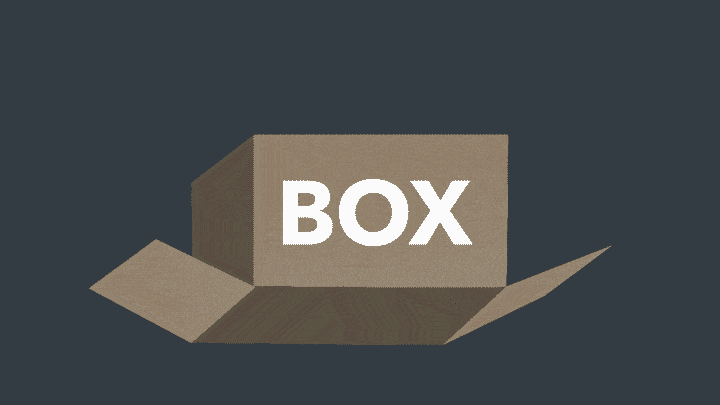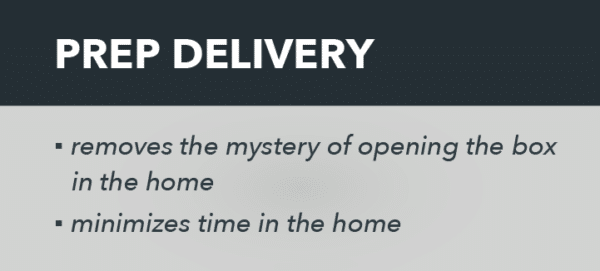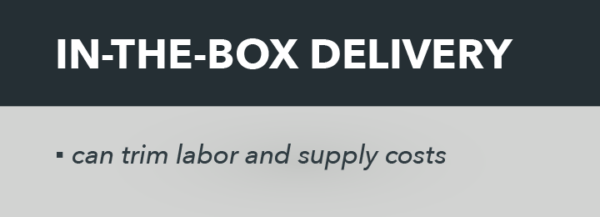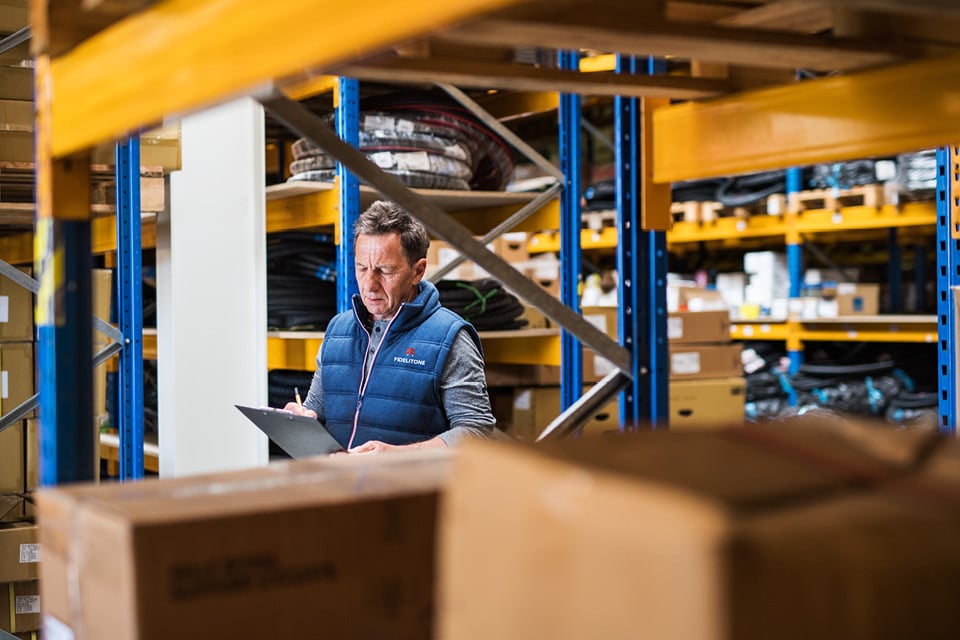Last Mile Delivery: Should You Prep First?

What’s in a box? When it comes to your delivery processes, sometimes the answer is cost savings. Delivering large goods in the box, just as they came from the manufacturer, can save labor. But can this practice also put your customer experience at risk?
“Prep” vs. “Deliver in the Box”
First, some definitions:
In “prep” delivery (short for “prepare”), we remove the product from the manufacturer’s packaging, inspect the product for any damage, and then blanket wrap and stretch wrap each piece to ensure the product arrives damage-free.
In “deliver in the box” delivery, we do not remove the product from the manufacturer’s packaging and deliver the product in the box, unboxing in the home.
When determining which delivery approach to use, consider how cost and customer experience intersect. Let’s take a closer look at the factors involved.
Prep Delivery and the Customer Experience
It’s easy to think that prep delivery creates an optimal customer experience. And generally, that’s true. Prep delivery can offer the high-touch, professional feel that customers crave. There is nothing like the sight of a carefully wrapped piece of furniture or fitness equipment being vigilantly wheeled into the home.
This is about brand impression: After carefully selecting just the right piece, sometimes at significant consideration and expense, a customer expects equally great care from the retailer in providing a perfect delivery.
Phil Britt, writing in CMS Wire, explains, “Failures such as late delivery or damaged product directly impact customer satisfaction and brand loyalty.” Prep delivery absolutely removes the mystery of opening the box in the home. Discovering damage in this final leg of the customer journey is bound to be a serious let-down for the eager customer. Not only does it delay final enjoyment of the product, it also requires a customer to schedule time at home again for another delivery. It erodes confidence in your brand. If you have furniture techs involved, you can spot and repair damages in-house prior to delivery, saving time, money and customer loyalty.
The quality of the home delivery experience greatly affects your ability to earn customer loyalty. Learn more about winning over your customers. According to a customer experience study reported in Forbes, 79% of consumers stated they would take their business to a competitor within a week of a poor experience. If you do prep delivery, you can ensure the first time is always the charm! Providing the best in-home brand experience possible helps earn customer loyalty, boost repeat sales, and generate glowing social media reviews and word-of-mouth referrals.
Another plus for the customer experience with prep is the compressed time frame required in the customer’s home. Customers are busy and appreciate not having a delivery team in the home longer than necessary. The wrapped, pre-assembled piece can be delivered quickly and neatly, as compared with unpacking boxes and then cleaning up cardboard, corner boards, Styrofoam, and other packing materials.
Less time in the home also means more stops per day, which can favorably impact costs for last mile delivery.
With all the benefits that prep delivery provides, prepping is successful only when you have solid processes and well-trained, experienced, and passionate prep specialists and delivery teams. These employees understand the importance of customer experience and work hard to make it enjoyable. Inexperienced, poorly trained team members can incur damage to the piece being delivered—and to the relationship with the customer.

Cost Containment for Last Mile
From the perspective of cost containment, there are pros and cons to each delivery solution.
Deliver in the box can trim labor and supply costs, because the driver just takes the box to the customer’s home. There is no need to incur labor expense to prep the product or materials expense to wrap and protect the product. What’s more, it can help retailers make a case for a damage claim. Here’s why: Manufacturers make an effort to optimize product packaging for protection during transport—often overseas. When a product is removed from the manufacturer’s packaging, the manufacturer may push back arguing the product should have not been removed from their packaging. This makes filing a claim with the manufacturer more difficult.
Paradoxically, deliver in the box can also drive up costs. An important metric in last mile delivery is the number of stops per truck—a number we always want to see as high as practical. Sometimes bulk protective manufacturers packaging eats up excess space in the delivery truck, as compared with efficient loading of unboxed products by drivers to maximize space in the truck. This can lead to fewer stops per truck, reducing cost efficiency and eroding profitability.
When there are damages, there are returns and associated costs: returning the damaged product to your warehouse, shipping the damaged product back to the manufacturer, shipment of a replacement, and re-delivering to a customer’s home. Prep can eliminate or reduce these costs…even more so when you have a furniture tech in your delivery hub.
As a best practice at FIDELITONE, if we are asked to deliver a replacement for a damaged product that was delivered in the box, we prep it the second time to avoid repeating a disappointing experience for the customer. From a cost perspective, though, it makes sense simply to have prepped the item in the first place.

As a retailer, if you opt to have products delivered in the box, you may also have to invest more in packaging to minimize damage. This investment may translate into both supplies and labor as you extend protective packaging. If you are not investing heavily in packaging, it may be more cost-effective simply to prep instead.
The Last Mile Decision
If your consumer product is furniture such as sofas, chairs, desks, bookshelves, tables, beds, cabinets, hutches, armoires, dressers, mirrors, or outdoor furniture—or high-tech or fitness equipment—you can see the case for either prep delivery or delivery in a box.
The best decision will not be the same in every situation. If a product takes a long time to assemble, or if it tends to incur damage in shipment, or if you’ve chosen to reduce expenses in packaging, you may want to choose prep. The brand promise you have with customers is paramount: What do they expect from your brand, and how can you best deliver on your brand promise?
There will always be a need for both delivery styles, and you can turn to a last mile delivery expert like FIDELITONE to provide expert services for both. FIDELITONE’s national last mile delivery network includes hubs in 30+ cities, including Chicago, IL.
To learn more, contact us and let’s spend some time understanding your business needs and working together on a solution that addresses your goals for cost reduction and customer experience. Contact us today!
FIDELITONE helps you earn customers’ loyalty through specialized services in inbound logistics, order fulfillment, last mile delivery and service parts management.
Recent Posts
-

How to Choose a Global Ecommerce Fulfillment Partner
In today’s interconnected global economy, international trade is no longer a maybe, but for most…
-

Elevating Your Supply Chain: FIDELITONE’s Latest Facility Openings in Raleigh, Virginia Beach, and Reno
FIDELITONE is thrilled to announce the launch of three advanced facilities strategically positioned in Raleigh,…
-

How to Reduce Warehouse Costs in a Down Market
Order volumes have slowed down while excess warehouse capacity inches upward. How do you manage…
Are you interested in order fulfillment or last mile delivery services? Consult with a FIDELITONE expert to discuss how we can help.
